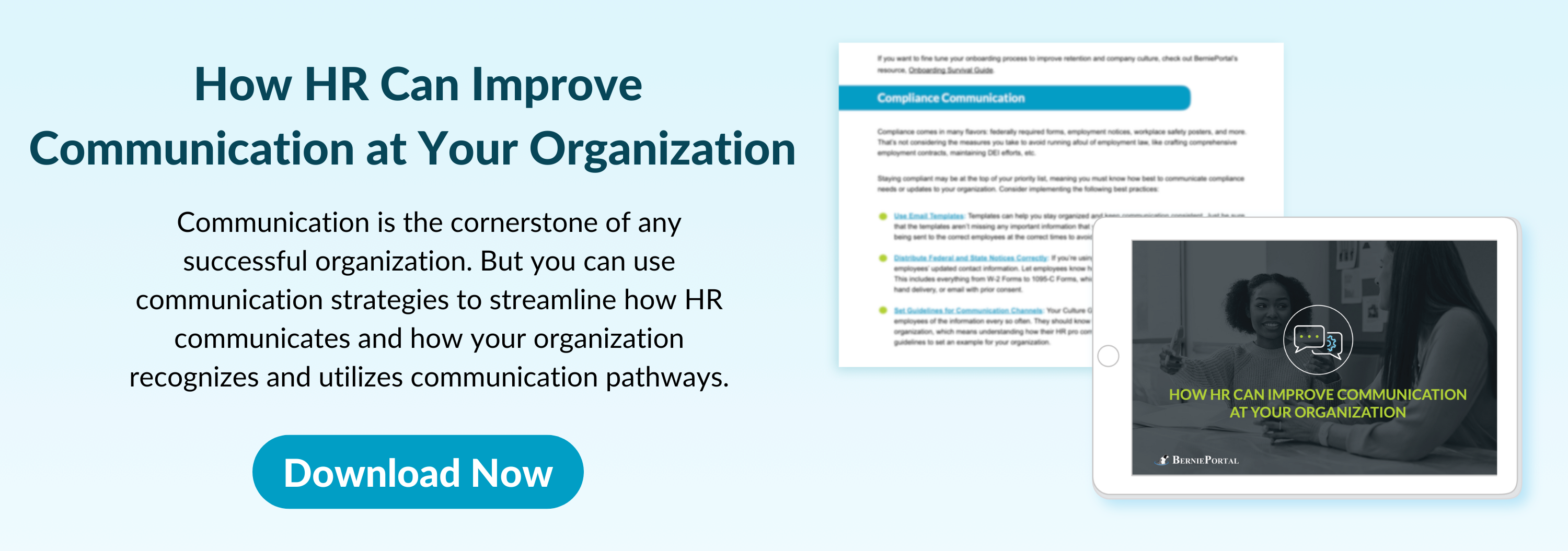
Written by
Aidan Farrish
Aidan is an aPHR-certified writer on the marketing team at BerniePortal. She writes about HR, healthcare, and benefits.
Template: How to Communicate PTO Policy Updates

Employers who care about retention should care about their PTO policy, too. Similarly, HR pros should regularly conduct a PTO audit to stay compliant and protect the bottom line. When making changes to your PTO policy after an audit, it's important to clearly communicate updates to employees.
Here's a template you can use to announce those PTO policy updates to your workforce.
How to Communicate a PTO Policy Change to Employees
As the workforce and labor laws are constantly changing, PTO policies require regular review for companies to remain competitive, compliant, and financially solvent. How you communicate updates to an existing leave policy is especially important to company culture, and transparency can go a long way in this messaging.
To that end, you should include the following information:
1. Explain the Reason for the Audit: Employees may be frustrated with the change, especially if they might “lose” accrued PTO), but they’ll appreciate the respect of transparency when explaining the reason.
2. Detail the Updates: Whether capping rollover amounts, increasing annual allotted days, or switching completely to an unlimited approach, HR should include exactly what’s changed and why.
3. How the Policy Impacts Hourly vs. Salaried Workers: Depending on the policy, changes may affect one group of workers and not the other--such as exempt vs. nonexempt. Any communication from HR should be specific to avoid confusion.
4. Display the Policy: PTO is there for employees to use, so they should be able to access the policy at any time. Post it in a highly visible area in the office or host it on the organization's intranet. This will provide even more transparency between HR and employees.
5. Start Date: Employees need to know when to expect the changes will take place--whether effective immediately or months down the road.
6. Anticipated Questions: HR should stay ahead of the curve with pre-generated responses to expected questions that employees may ask when the policy is announced.
Template: PTO Policy Update Communication
Use the communication tips above and the template below when promoting PTO policy changes to employees:
Team,
I’m reaching out today regarding an update to [Company]’s PTO policy. HR audited the team’s time-off benefits and updated the plan with a new policy that will help keep our organization financially healthy—now and in the future.
With this in mind, beginning [date], we’ll implement the following changes to our PTO policy:
- PTO will be available to exempt and non-exempt employees.
- Employees receive their allotted PTO at the beginning of the calendar year.
- All PTO requests and approvals will be tracked using [system].
- PTO allotments are as follows:
0-5 years of service – [days] PTO days each year for exempt employees; [days] PTO days each year for nonexempt employees.
6-10 years of service – [days] PTO days each year for exempt employees; [days] PTO days each year for nonexempt employees.
10+ years of service – [days] PTO days each year for exempt employees; [days] PTO days each year for nonexempt employees. - PTO requests may not be approved during [quarter], which is our busiest time of the year; we encourage employees to work with their managers to identify appropriate periods for time-off during this time
- Employees may roll over up to five days of unused PTO from one year to another; any unused PTO exceeding five days is forfeited at the beginning of the new calendar year
[Company] expects some employees may have questions about the new policy. HR produced a set of anticipated FAQs—available here [link]—that should address any concerns you may have.
If you have any additional questions about the PTO policy, please contact [contact information].
As always, thank you for your commitment to our team,
[Name]
For more templates, and insider know-how on HR communication, check out our free resource below.
FAQs: How to Communicate PTO Policy Updates
-
Why should I explain the reason for a PTO audit? Employees appreciate transparency. Sharing the "why" behind changes builds trust and reduces resistance.
-
What’s the best way to ensure employees understand policy updates? Post the policy in a visible location, provide FAQs, and encourage questions through dedicated communication channels.
-
Can I use the same policy communication template for remote workers? Yes, but make sure to include instructions for accessing the policy via the company intranet or email.
Additional Resources
Aspiring HR pros need to be in the know. You can stay informed, educated, and up-to-date with important HR topics by using BerniePortal’s comprehensive resources:
- BerniePortal Blog—a one-stop-shop for HR industry news
- HR Glossary—featuring the most common HR terms, acronyms, and compliance
- HR Guides—essential pillars, covering an extensive list of comprehensive HR topics
- BernieU—free online HR courses, approved for SHRM and HRCI recertification credit
- HR Party of One—our popular YouTube series and podcast, covering emerging HR trends and enduring HR topics

Written by
Aidan Farrish
Aidan is an aPHR-certified writer on the marketing team at BerniePortal. She writes about HR, healthcare, and benefits.
Related Posts
Part-time work is becoming increasingly common in today’s workforce—especially for...
As you know, healthcare and benefits can be complicated, which can make the enrollment...
With the deadline for filing and distributing 1095-C forms approaching, staying...
A strong paid time off (PTO) policy helps retain current talent and attract prospective...









Submit a Comment